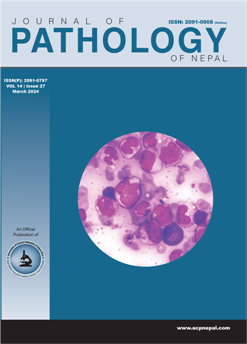RDW-SD - A more sensitive marker of anisocytosis than RDW-CV in patients with macrocytosis
DOI:
https://doi.org/10.3126/jpn.v14i1.55709Keywords:
Anisocytosis, Macrocytosis, RDW-SDAbstract
Background: Anisocytosis is a variation in RBC size. This can be conventionally observed on peripheral blood smear microscopy and also by red cell distribution width, a RBC parameter obtained on automated hematology analyzers. Red cell distribution width is considered a quantitative measure of anisocytosis and does not carry subjective variation associated with microscopy and it is reported as RDW-CV % and RDW-SD. Both these values are calculated differently. Although it is one of the most frequently used hemogram parameters for anisocytosis, it is not well understood. This study aimed to compare the sensitivity of RDW-CV and RDW-SD as markers of anisocytosis in macrocytosis.
Material and methods: This was a cross-sectional prospective observational study conducted in a laboratory of a tertiary care hospital in western India. The sample size of 138 was calculated at a precision 0.1 and 90% confidence interval. 138 blood samples each from patients with macrocytosis and normocytosis control group were analysed.
Results: The range for RDW-CV & RDW-SD was 12.59%-15.13% & 40.05-47.81fl respectively in our population. Gender-wise distribution showed 72% male & 28% female. The Z score value of 4.12 (>1.96 is significant) reflected a significant difference in anisocytosis detection using RDW-SD compared to RDW-CV in macrocytosis.
Conclusions: RDW-SD is a more sensitive marker of RBC anisocytosis than RDW-CV in macrocytosis.
Downloads
Downloads
Published
How to Cite
Issue
Section
License
Copyright (c) 2024 The Author(s)

This work is licensed under a Creative Commons Attribution 4.0 International License.
This license enables reusers to distribute, remix, adapt, and build upon the material in any medium or format, so long as attribution is given to the creator. The license allows for commercial use.




